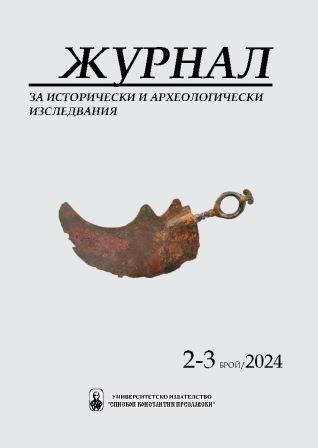Thracia Homerica: тракийският меч
Thracia Homerica: The Thracian Sword
Author(s): Ivo KaradzhinovSubject(s): History, Ancient World
Published by: Шуменски университет »Епископ Константин Преславски«
Keywords: Iliad; Trojan War; Ancient Thrace; Thracian warriors; offensive weapons; swords; Thraco-Hellenic contacts
Summary/Abstract: The article explores two passages in the Iliad relating to the use of a sword called “Thracian” (Hom. Il.: 13, 576–577; 23, 807–808; 824–825). Despite the given information being interpreted in various commentaries on the Iliad and in a number of studies devoted to the early history of Thracian communities, it has not been the object of specific research. The evidence is examined from the point of view of its characterisation in the text, the relations to the other testimonies in epic referring to Thrace and in the context of the sword finds in the North Aegean and its hinterland in Inner Thrace during the Late Bronze and the Early Iron Age. As a fragment of the complex narrative structure of the poem, the “Thracian sword” is situated in two different contexts – as a weapon used on the battlefield and as a prize in a funeral game. In both cases, the sword is not owned by Thracian warriors. The lack of a contextual connection between the Thracian contingents and the weapon is seen as a main issue in the examination of the source. The mention of the “Thracian” sword, however, form the plethora of the earliest written evidence of Ancient Thrace that reflects the mutual knowledge of the communities in the region. In the Homeric world, contacts with Thracians are represented by intercultural relations such as wine trade, gift exchange, intermarriage, and participation in military conflicts. These models of cultural interactions are commonplace in the poem and it is difficult to determine whether they indicate actual contacts between Hellenic and North Aegean communities. The uncertainties are fuelled by the lack of information in the preserved Trojan Cycle on the events in Troy at the end of the Late Bronze and the beginning of the Early Iron Age, when in layer VIIb (and VIIb2 in particular) occurred a marked change in the material culture, associated with the settlement of inhabitants from Inner Thrace. From this perspective, the question whether the testimony refers to an existing weapon or it is a product of literary invention remains open.
Journal: Журнал за исторически и археологически изследвания
- Issue Year: 2024
- Issue No: 2-3
- Page Range: 20-46
- Page Count: 27
- Language: Bulgarian

